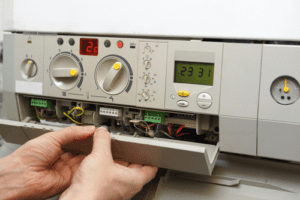Spring might be just around the corner, but that doesn’t mean you can stop relying on your furnace just yet. In many areas throughout California and the continental United States, spring nights can still be chilly. If that’s the case in your region, you’ll probably continue to rely on your furnace for at least another month or so after the sun has gone down, and night has fallen. However, you might have a harder time staying comfortable than you thought you would if you’ve recently turned on your system to discover that your gas furnace is not working.
Finding out that your gas furnace is not working can be a major inconvenience, so it’s vital that you understand why. Once you do, you will be able to take stock of your options and pursue the strategy most likely to fix the issue cost-effectively. Gas furnaces can suffer from several different maladies, and the cause of the trouble may not always be easy to identify. Don’t worry though—we’re here to help with a guide as to why your gas furnace may not be working the way you want.
The Most Common Reasons Why a Gas Furnace is Not Working
 We deal with plenty of customers who come to us for troubleshooting on their gas furnaces, so we have a pretty solid understanding of what the most common problems are. Here’s what we’ve noticed are the leading causes of gas furnace trouble. Familiarize yourselves with the following issues and their symptoms so that you can prevent them or fix them quickly when they occur.
We deal with plenty of customers who come to us for troubleshooting on their gas furnaces, so we have a pretty solid understanding of what the most common problems are. Here’s what we’ve noticed are the leading causes of gas furnace trouble. Familiarize yourselves with the following issues and their symptoms so that you can prevent them or fix them quickly when they occur.
- Neglect: the most common reason by far for a furnace to stop working properly is simply that the owner has forgotten to provide it with appropriate levels of care and maintenance. Many furnace owners believe that it is cheaper to avoid paying for service calls or professional help of any kind until there is an emergency that requires a contractor, but this is far from the truth. In fact, hiring a licensed professional to provide routine service for your system once or twice a year is demonstrably effective in reducing the number of costly emergencies you will face over the course of your furnace’s lifetime. Neglect often leads to blockages in your ducts, which can, in turn, cause many expensive issues.
- Unclean Air Filters: one of the best ways to avoid neglecting your furnace is to merely change the air filters every month while the system is in use. Doing so will prevent unwanted foreign material from sneaking into your ducts, where it can eventually build up and cause a full-scale blockage. Blocked ducts will not allow enough air to move through your system when it is running. As a result, the temperature in your home will not be as high as the temperature on your thermostat, and the furnace will work harder than necessary to compensate. As such, it will place too much strain on the components in your furnace and may destroy them well before their time.
- Ignition Issues: your furnace burns gas, which means it needs a way to light that gas and produce heat. That’s the job of your ignitor, which usually comes in either the form of a pilot light (for older systems) or an electric igniter (in many newer ones). If the ignitor in your furnace is dirty or broken somehow, it will not be able to light the gas in your system, and your furnace will not produce any heat. However, be advised that it is never a good idea to clean the ignitor by yourself. Pilot lights are notoriously sensitive, and electric igniters may not be much more robust. The surest way to deal with this problem without making it worse is to call a professional who can treat the component in question properly.
- Thermostat Problems: it might surprise you to know this, but many furnace problems have very little to do with the furnace itself. Instead, they may be caused by a thermostat that is sending the wrong information (or no information) to the furnace. When a thermostat is programmed improperly, suffering from electrical problems or simply out of batteries, it can cause the furnace to act up or remain inert. Check your thermostat before assuming that your furnace itself is broken.
- Wear and Tear: sometimes, components in your furnace merely stop working because they’re old. A well-maintained furnace can last for years—perhaps even longer than a decade. However, when your furnace begins to approach the 10-year mark, malfunctions and breakdowns will start to become more common. If you have an old furnace, don’t be surprised to encounter a few unexpected issues. You might even consider replacing the system when it becomes that old.
When your gas furnace is not working, remember that the cause of the problem is usually fairly straightforward. Check your thermostat, take a look at your ignitor, call a professional to clean your ducts, and remember to change your air filters. Paying attention to such little things can ensure that your system provides you with many years of reliable use.
Check with us here at Valley Comfort Heating and Air, our customers love our attention to detail and our friendly, affordable service. (707) 539-4533
